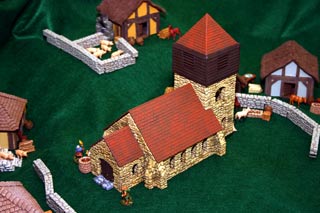
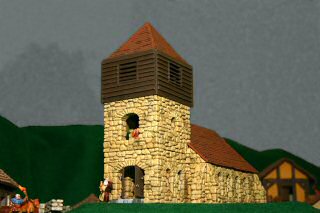
This article describes the design and construction of a 25mm (1/64th) scale miniature model Saxon Church. The model is constructed using plaster blocks cast from Hirst Arts silicone molds, primarily the Fieldstone Wall mold (#70) and the Flagstone Floor Tile mold (#260). The rest of the model is constructed from bass wood, card stock, and various hobby materials. The model is painted with latex and acrylic paints and sealed with matte varnish so it can be used in a variety of miniatures games, in dioramas, or as a decorative piece.
Saxons were inhabitants of southern England and the northern German region of Saxony.
They flourished after the decline of the Roman Empire in Britain (400 A.D.)
and declined after the Norman invasion of Britain in 1066 A.D..
The most famous king was King Alfred who established many towns,
promoted trade, established laws, and fought the Danes.
Much of his work is still evident in England today not only in Saxon architecture, but
in the layout of roads, estates, and towns.

|
|
|
Surrounding the church in this photo are the homes of the villagers.
These wattle and daub building models were also built with Hirst Arts molds
and various hobby materials.
The buildings are made with a cross section of an orange juice cartons.
Planks from the Wooden Plank mold (#260) are glued to the cartons.
Then a bit of spackle is pasted to the carton to give it some texture.
The roof is made with matte board (the heavy cardboard used in picture frames),
and the roof thatch is made with fur material from the local fabric store.
Some of the buildings in the foreground have wood shake roofs made
from Hirst Arts Wooden Shingle mold (#240).
All the buildings are painted with latex and acrylic paints to give the village
a hodge-podge of color.
Walls are made with pieces from the Fieldstone Wall mold.
Farm animals are the 25 cent type for kids found at toy stores.
You can never have too many rubber pigs for Dark Ages miniature gaming.
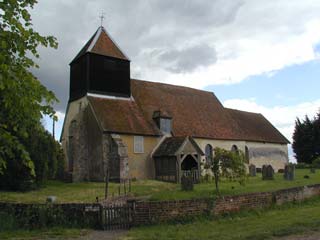
|
|
|
Saxon churches have two main parts: a nave or assembly hall for the people
and a smaller chancel which is the domain of the priest.
Often they also had a bell tower as shown here encased in dark colored wood.
Other examples of Saxon churches exist in Bradford-on-Avon (Wiltshire), Earls Barton (Northamptonshire),
Escomb (Durham), and Bradwell-on-Sea (Essex) (founded by St.Cedd in 654.)
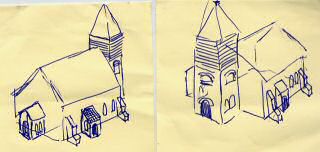
|
|
|
I also made the tower separate from the main part of the church.
This is basically a concession to make the model easier to build
and dismantle.
The design also called for small wooden entryways, one of them at the side.
Most Saxon parish churches did not have furniture or a longitudinal aisles.
Many of them, including this church at Hursley have a simple side entry.
I made a small change of plan and included a somewhat grand (by Saxon standards)
front door.
One of my goals was to make a nice focal point for miniatures gaming, so I
wanted to have a big door that the villagers could barricade and Vikings could
knock down.
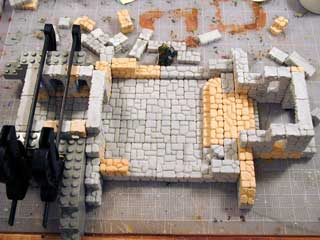
|
|
|
On the left side of the photo, we see another vestibule which forms the chancel for the priest. It's only a small room, but perhaps here is where the priest will store the treasures of the church. Additionally there is a raised platform for the church altar or a lecturn.
To assemble the model, I use ordinary Elmer's Tacky Glue, which is a bit thicker than Elmer's White Household Glue. The nice thing about the sticky glue is that is really holds the pieces together well. Also, if you make a construction error, you can soak the blocks in water and they will come apart. Once you paint the model, the glue is encased so that is relatively water proof. Still I don't know how well these models will hold up outdoors in the rain in the garden. In that case you might want to use an epoxy based glue such as Liquid Nails brand.
A 25mm figure oversees the work and helps denote the scale of the model.
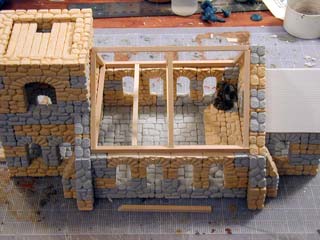
|
|
|
My bricks are made of both gray and beige plaster. As the entire model is soaked in dark primer paint, the underlying color of the plaster does not matter.
Now the roof goes in. I made the frame of the roof with bass wood. The frame is covered with matte board, the heavy cardboard that is used in picture frames. The frame is not glued to the walls in order to make a removable roof so that you can place figures in there and have a big battle.
Also notice that the second floor of the bell tower has
been completed.
They are made with some spare planks
of the Wooden Plank mold.
Of course there is a hole in the floor to allow the bell ringers
to climb and descend.
The floors of the bell tower are removable in order to make the structure
easier to paint.
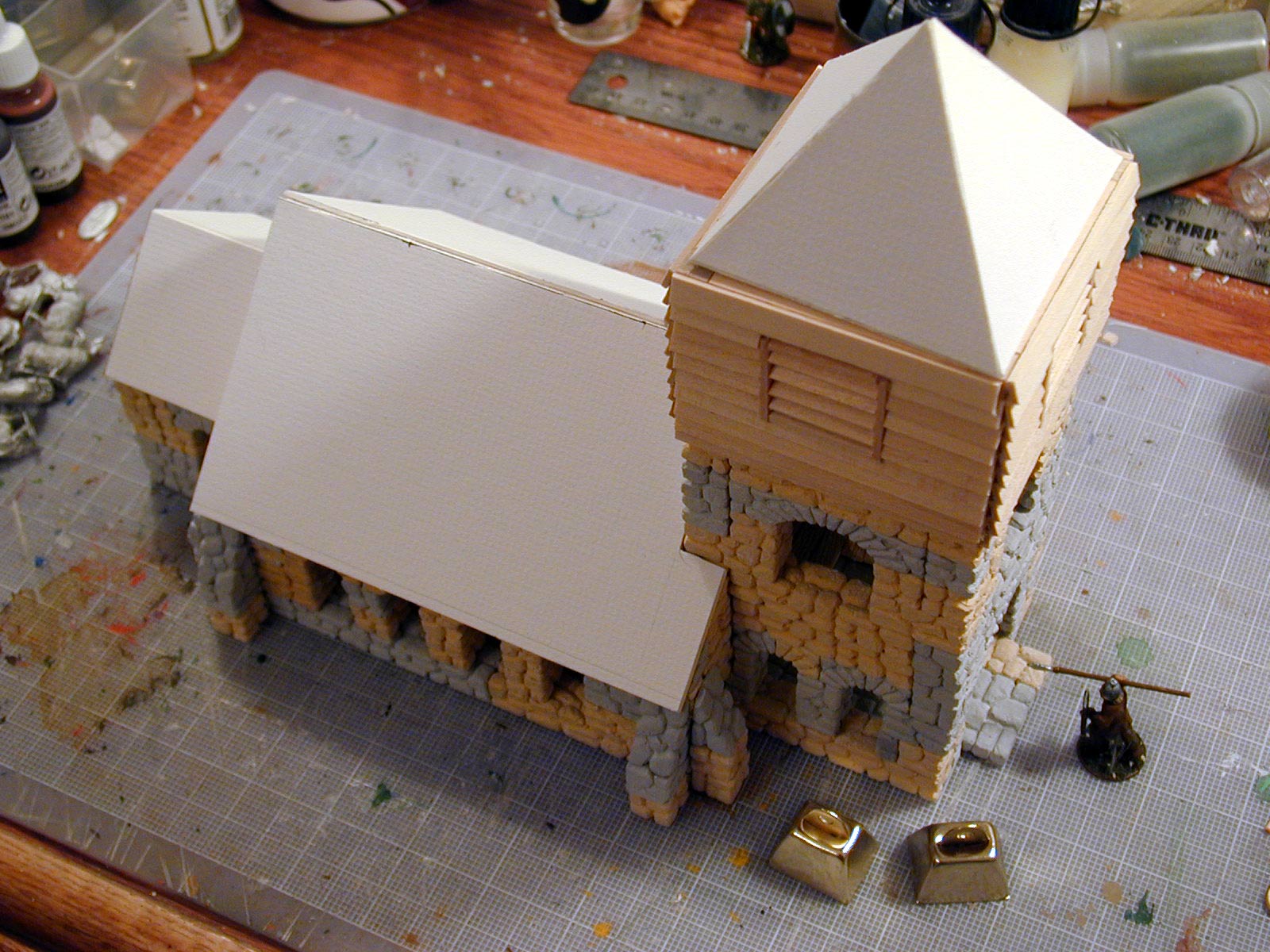
|
|
|
Some hobby material manufacturers such as
Midwest Products or
Northeastern Scale Lumber Company
actually make milled plank sheets so that this
cubic bell house could be made with four square sheets.
However, as most scale lumber is designed for HO scale, I could not find the
size planking I wanted and had to build the planks by hand.
The window vents were also hand constructed.
It was a tedious task, but it makes the bell house look very rustic.
As with the stone tower, the bell house is not glued to the tower in order
to make it removable and easily paintable.
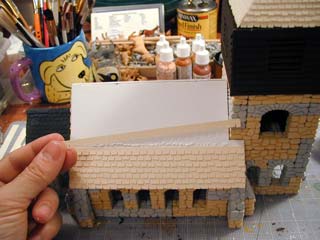
|
|
|
Some of the hobby material manufacturers make scale roofing.
However, I just didn't find anything close to what I wanted.
So I decided to use manila folder paper and hand cut smaller
tiles.
Each tile strip is about 3/8" (9mm) deep, and each tile cut is about 1/4" (6mm) wide.
This roof was especially tedious to make, but I think the final result looks
very close to the Hursley Church.
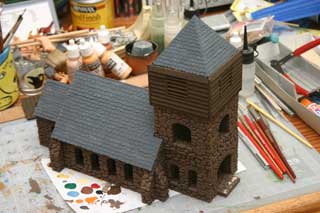
|
|
|
Notice the messy hobby desk.
Space and time are at a premium here.
I often do not finish one project before beginning another.
One day I hope to get that Viking ship in the background all done,
and you'll be sure to read about it here at this site.
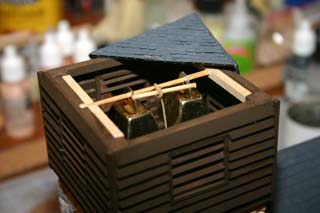
|
|
|
The photo shows how the bells are constructed. Inside the bell house there is a round cross bar that axis as the axle on which the bells swing. On the cross bar hang two brass bells that one can purchase at a craft store such as Michael's or Hobby Lobby. I cut a notch into the hanger of each bell and in the notch I glue a second cross bar with a rope attached to it. Since the second cross bar is off the rotating axis of the main cross bar, pulling on the rope causes the bells to swing and ring out the glorious chimes.
Of course, most Brits are fond of ringing changes, but you will
find it hard to replicate that endeavor with this model.
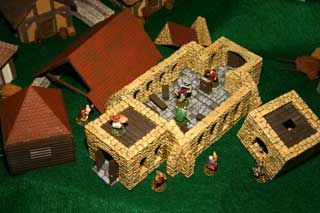
|
|
|
As you see, it all comes apart to place figures and other hidden treasure inside.
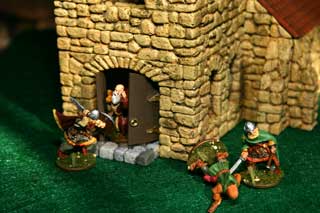
|
|
|
Aye, they've killed Herman the Woodsman with one stroke of the broadsword. It's clear that these heathens can't be bought off.
Quick, brother Maynard, close the door.
One of those beasts is trying to get in.
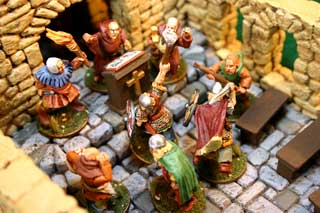
|
|
|
"Out of this Holy abode!" shouts Brother Ignats
at a wooden lecturn made with scrap bits of bass wood painted brown.
"In the name of Lord and by the word of this bible,"
constructed from two chips of bass wood
and painted to resemble an illuminated manuscript,
"leave this house now."
Pandemonium breaks loose as the big melee unfolds in this
once peaceful Saxon Church.
Thanks for reading this far. If you like this modelling project, you may also enjoy some of the gaming models I have constructed and discussed in other articles: